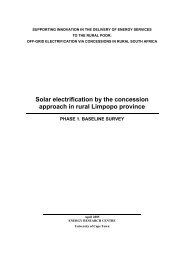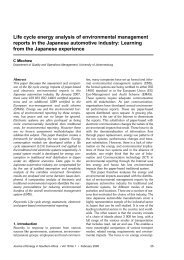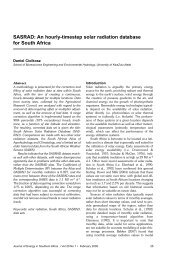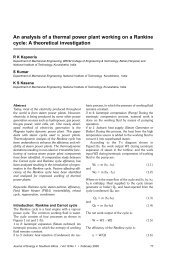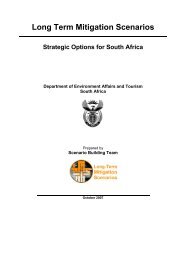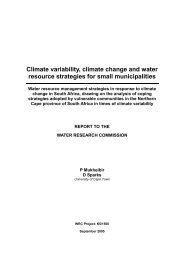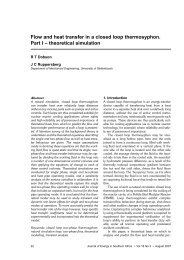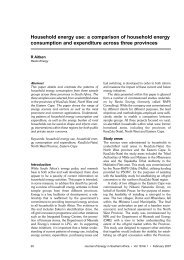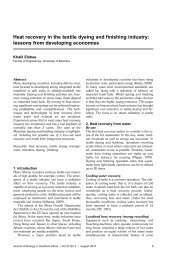Stainless steel finned tube heat exchanger design for waste ... - erc
Stainless steel finned tube heat exchanger design for waste ... - erc
Stainless steel finned tube heat exchanger design for waste ... - erc
Create successful ePaper yourself
Turn your PDF publications into a flip-book with our unique Google optimized e-Paper software.
Introduction<br />
The mid 20 th century has proven to be a time during<br />
which the world has had a rude awakening from<br />
its relaxed attitude towards the usage of our depleting<br />
natural resources. Proof of this is the <strong>waste</strong> <strong>heat</strong><br />
recovery systems that have been in use in industries<br />
all over the world <strong>for</strong> the last 50 years. An example<br />
of this is the integration of various factory sections<br />
where the <strong>waste</strong> <strong>heat</strong> from one section is used in<br />
another. This is common practise in the food industry<br />
and not only saves money, but streamlines production<br />
and results in better efficiencies. Nonetheless,<br />
a large amount of energy is still being lost in the<br />
<strong>for</strong>m of <strong>heat</strong> generated by everyday industrial and<br />
domestic equipment (Koorts 1998).<br />
The definition of <strong>waste</strong> <strong>heat</strong> includes the following:<br />
unburned but combustible fuel; sensible and<br />
latent enthalpy discharge from exhaust gas mixtures;<br />
and sensible <strong>heat</strong> discharge in liquid <strong>waste</strong> (Al<br />
Rabghi et al 1993).<br />
A quarter of the energy consumption in the<br />
western world is centred in the transportation sector.<br />
Automobiles and trucks account <strong>for</strong> approximately<br />
80% of all transportation energy expenditures.<br />
These thermal engines operate with a thermal<br />
efficiency between 30 and 40% (Koehler et al 1997).<br />
The typical energy balance <strong>for</strong> a turbocharged<br />
diesel engine, as tested by Stellenbosch Automotive<br />
Engineering (Wipplinger 2000), is as follows: oil<br />
cooling (2%), air cooling (5%), water cooling<br />
(25%), exhaust gasses (33%) and mechanical<br />
power (35%). It is clear that approximately one<br />
third of the total energy released by the combustion<br />
process is lost along with the exhaust gas, while one<br />
third is transferred to the cooling fluids and the rest<br />
is converted to actual mechanical power. The cooling<br />
fluids are necessary losses which prevent catastrophic<br />
failure of the engine due to over<strong>heat</strong>ing.<br />
But the energy lost along with the exhaust gas, can<br />
be ascribed to the inefficient utilisation of the available<br />
energy, which makes research into the recovery<br />
of <strong>waste</strong> energy and subsequent efficiency and<br />
fuel utilization improvement, a viable option.<br />
While it is well known that sensible hydro-carbon<br />
combustion <strong>waste</strong> <strong>heat</strong> recovery is a common<br />
practice in large units found in marine applications,<br />
the present study <strong>for</strong>ms part of ongoing investigations<br />
desiring to examine ways <strong>for</strong> exhaust gas<br />
<strong>waste</strong> <strong>heat</strong> recovery on smaller units, e.g. trucks<br />
and locomotive engines. The final system <strong>design</strong><br />
would ideally convert the recovered energy into<br />
electricity by implementing a turbine and generator<br />
combination.<br />
In a detailed study done by Wipplinger (2004),<br />
the following premises were accepted: The sensible<br />
<strong>heat</strong> must be recovered by means of a <strong>heat</strong><br />
<strong>exchanger</strong>, which will impose a low back pressure<br />
on the exhaust system. Latent enthalpy recovery is<br />
not envisaged at present as the condensation of any<br />
vapours present in the exhaust gas mixture is considered<br />
unfavourable to the exhaust system.<br />
Without committing to a downstream Rankine<br />
steam cycle and its variations (e.g. a Stirling engine<br />
might serve as an alternative), high pressure capability<br />
on the water side would be required. For various<br />
reasons discussed by Wipplinger (2004), a<br />
<strong>finned</strong> <strong>tube</strong> cross-flow configuration was considered<br />
the most suitable. In order to correctly specify such<br />
a unit, knowledge of the behaviour of two-phase<br />
flow and its subsequent <strong>heat</strong> transfer coefficients,<br />
are required.<br />
Two-phase correlations<br />
During the <strong>heat</strong> <strong>exchanger</strong> <strong>design</strong> process,<br />
described by Wipplinger (2004), a computer program<br />
was written in Microsoft ® Visual Basic 6 which<br />
simulated the conditions, and subsequent fluid/gas<br />
properties, inside the <strong>heat</strong> <strong>exchanger</strong>. Well known<br />
correlations were used to compensate <strong>for</strong> the various<br />
flow regimes, of which the following are the<br />
most important:<br />
Friedel Correlation <strong>for</strong> Frictional Two-phase<br />
Pressure Gradient<br />
The Friedel Correlation (Friedel 1979) is probably<br />
the most generally available correlation <strong>for</strong> the frictional<br />
two-phase pressure gradient. It is written in<br />
terms of a two-phase multiplier<br />
48 Journal of Energy in Southern Africa • Vol 17 No 2 • May 2006




